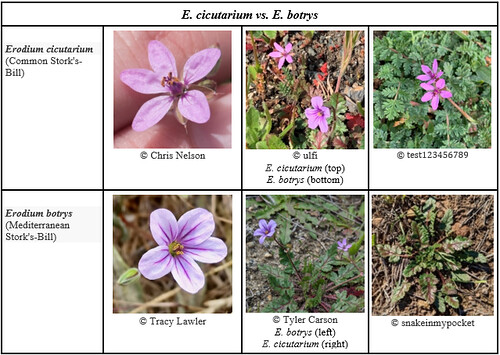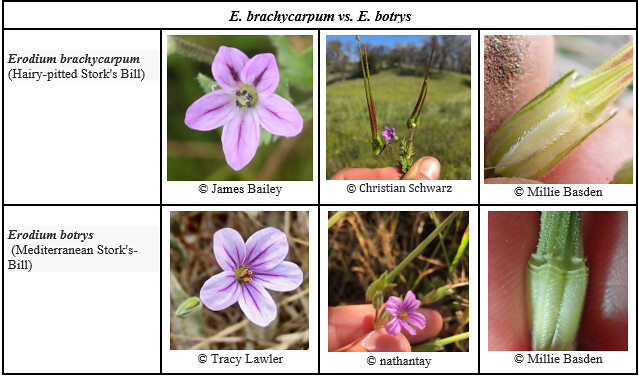How to identify Erodium botrys (Mediterranean Stork's-Bill)
This project collects observations of Erodium botrys (Mediterranean Stork's-Bill) in California for the purpose of facilitating identification and preventing misidentification of this species in iNaturalist.
Photo tips:
- It’s essential to get a picture of the entire plant.
- It's also helpful to get close-up pictures of the face of the flowers, sepals, leaves, and fruits, if present.
- If the flower is smaller than your thumbnail, it’s helpful to get a measurement to differentiate from E. brachycarpum.
- If there are multiple plants in the picture, it’s helpful to crop your photo to focus on the plant of interest.
How to identify Erodium botrys:
- Height: Grows to heights of 10 to 90 cm (4-35 in)
- Stems & Leaves: This plant starts from a flat rosette of green leaves on red petioles. Leaves are lobed or dissected, with the reddish veins clearly visible in the younger leaves. Leaf blades are deeply lobed or compound. Stems and foliage are somewhat hairy. The hairs on the pedicel are short and straight, and many are clearly glandular.
- Flowers: Small lavender or pink flowers have five purple-streaked petals. The flowers are more cup-shaped, with broader petals than other Erodiums. Sepals are pointed with bristly tips. A distinctive feature is that one of the five sepals always has a dark red stripe on its margins.
- Fruit: The fruit is quite long; its style can reach up to 12 cm (4.7 in) in length, while the fruit body is 8-11 mm.
- Habitat: Can be found in dry, open or disturbed areas.
- Peak Flowering Time: Feb - May (according to Calflora); Mar - July (according to eJepson) Note: Season is not really useful for identifying these plants since they respond to prime conditions (e.g. rain) at any time of the year. They can be seen blooming in July, but the foliage is very shriveled and the plant overall is much smaller than during the peak flowering months.
Similar Species:
- Erodium cicutarium (Redstem Stork's-Bill)
- Erodium brachycarpum (Hairy-Pitted Stork's-Bill)
How to differentiate E. botrys from E. cicutarium:
- Both species can have red stems, so stem color is not helpful for differentiating these two species.
- E. botrys has dark purple streaks on the petals; E. cicutarium petals don’t.
- E. botrys flowers are 3x larger and the petals are broader; E. cicutarium petals are narrower.
- One of the five E. botrys sepals always has a dark red stripe on its margins; E. cicutarium sepals don’t have the red stripe.
- E. botrys fruit beak is usually 7.5‒8.5 cm long, compared with 3.0‒3.5 cm long in E. cicutarium.
- E. botrys leaves are thicker, almost succulent; the leaves of E. cicutarium are finer.
- These two species often grow together in the same place.
Here are some observations that shows the two species side-by-side:
** https://www.inaturalist.org/observations/5620048
** https://www.inaturalist.org/observations/47402200
** https://www.inaturalist.org/observations/71672569
** https://www.inaturalist.org/observations/40772820
** https://www.inaturalist.org/observations/40997628See these projects for many examples of each species:
** https://www.inaturalist.org/projects/erodium-cicutarium-red-stemmed-filaree
** https://www.inaturalist.org/projects/erodium-botrys-mediterranean-stork-s-bill
How to differentiate E. botrys from E. brachycarpum:
- E. botrys is about 3x the size of E. brachycarpum.
- E. botrys has symmetrical flowers with broader blunt-tipped petals; E. brachycarpum has bisymmetrical flowers (with two slightly larger petals above three slightly smaller ones).
- E. botrys petals have multiple dark stripes; E. brachycarpum has a single dark stripe on at least one group of petals.
- One of the five E. botrys sepals always has a dark red stripe on its margins; E. brachycarpum sepals don’t have the red stripe.
- E. botrys has pedicel hairs that are longer, curved upwards, and not glandular. E. brachycarpum has hairs that are shorter and straighter, and many are clearly glandular.
See these projects for many examples of each species:
** https://www.inaturalist.org/projects/erodium-botrys-mediterranean-stork-s-bill
** https://www.inaturalist.org/projects/erodium-brachycarpum-hairy-pitted-stork-s-bill
References:
- Calflora: https://www.calflora.org/app/taxon?crn=3446
- Jepson eFlora: https://ucjeps.berkeley.edu/eflora/eflora_display.php?tid=25037
- Monterey Wildflowers: https://montereywildflowers.com/geraniaceae-erodium/
- Yosemite Hikes: https://www.yosemitehikes.com/wildflowers/filaree/filaree.htm
- http://www.flora.sa.gov.au/cgi-bin/speciesfacts_display.cgi?form=speciesfacts&name=Erodium_cicutarium
- “Plants of the San Francisco Bay Region: Mendocino to Monterey”, Beidleman, Linda H. and Kozloff, Eugene N. (University of California Press, Berkeley, 2003)
- "Eat the Weeds: Stork’s Bill, Cranesbill" http://www.eattheweeds.com/erodium-circutarium-geranium-carolinianum-two-bills-you-want-to-get-2/
iNaturalist:
** How to identify Erodium botrys (Mediterranean Stork's-Bill)
** https://www.inaturalist.org/taxa/47687-Erodium-botrys
** Parent Project: https://www.inaturalist.org/projects/erodium-genus-stork-s-bills-california/
** https://www.inaturalist.org/projects/erodium-botrys-mediterranean-stork-s-bill
** https://www.inaturalist.org/projects/erodium-seeds
** https://www.inaturalist.org/projects/erodium-phytopathology








Comments
Thanks for this!
You're very welcome.
I'm blown away by how much useful information you put together here-- with links to even more terrific information!
Thank you so much!
@aparrot1, your comment makes me happy. I'm so glad you find this info helpful. I gathered it as I was learning about Erodium in the hopes that it would help others learn to identify these plants as well.
Add a Comment